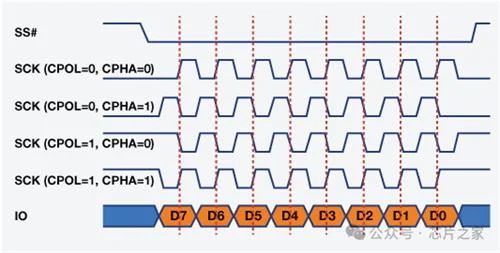I2C, SPI, and UART remain the most commonly used communication protocols in embedded electronic devices. In this article, we will delve into these three protocols to provide a clear and intuitive understanding of their functions, advantages, and limitations.
I2C Protocol

Overview:
I2C is a serial communication protocol typically used for connecting low-speed devices such as sensors, memory, and other peripherals. It utilizes two lines (SCL and SDA) for bidirectional communication and supports address directionality and master-slave mode.
Advantages:
- Multi-device support: I2C allows multiple devices to connect to the same bus, each with a unique address.
- Simplicity: The I2C protocol is relatively simple, making it easy to implement and debug.
- Low power consumption: Devices on the I2C bus can enter low-power modes during idle periods, conserving energy.

Disadvantages:
- Slow speed: I2C communication is slower compared to other protocols, which are suitable for low-speed devices.
- Limitations: The length of the I2C bus and the number of devices are limited, with longer buses potentially causing communication issues.
- Conflicts: Concurrent data transmission from multiple devices may lead to conflicts, requiring additional conflict detection and handling mechanisms.
Applications:
I2C excels in simple and cost-effective communication environments. It is particularly adept at being used in small sensors, LCD screens, and RTC (real-time clock) modules. Additionally, due to its efficiency in compact circuits, I2C is useful in temperature control devices, battery management systems, and LED controllers. However, for projects requiring fast or long-distance data transmission, other protocols may be preferable.
SPI Protocol

Overview:
SPI (Serial Peripheral Interface) is known for its high speed, making it the preferred choice for fast communication. Unlike I2C, SPI operates with four lines: MISO (Master In Slave Out), MOSI (Master Out Slave In), SCK (Serial Clock), and SS (Slave Select), allowing full-duplex communication (sending and receiving simultaneously). While SPI (serial peripheral interface) is known for its high speed, making it a preferred choice for fast communications, it requires more pins than I2C. This might be a factor to consider in circuit design.
Advantages:
- High speed: SPI communication is fast and suitable for applications with high-speed requirements.
- Full-duplex: SPI supports full-duplex communication, allowing simultaneous data transmission and reception.
- Simplicity: The SPI communication protocol is relatively simple and suitable for rapid development and implementation.

Disadvantages:
- Complex wiring: SPI requires multiple lines for connection, potentially increasing hardware design complexity.
- Limited transmission distance: The transmission distance of SPI is limited, with longer lines potentially causing signal attenuation and interference.
- Master-slave mode limitation: SPI typically operates in master-slave mode, limiting the number of controller devices and making them unsuitable for multi-master device scenarios.
Applications:
SPI is well-suited for situations requiring fast and reliable data transmission, such as TFT displays, SD memory cards, and wireless communication modules. However, its effectiveness diminishes in complex systems with many agent devices.
UART Protocol

Overview:
UART (Universal Asynchronous Receiver/Transmitter) is a serial communication protocol widely used for its versatility and simplicity.
Unlike I2C and SPI, UART requires only two lines to operate: TX (transmit) and RX (receive). The protocol allows asynchronous communication, meaning the transmitter and receiver do not need to share a clock. The data is organized into packets, with each packet containing a start bit, 5 to 9 data bits, an optional parity bit, and one or two stop bits.

Advantages:
- Simplicity: The UART communication protocol is relatively simple and easy to implement and debug.
- Broad applicability: UART is widely used for communication between various devices, offering good compatibility.
- Distance: UART communication covers long distances and is suitable for scenarios requiring extended transmission.
Disadvantages:
- Low speed: UART communication has a relatively low speed, and it is not suitable for applications that require high speed.
- Full-duplex: UART communication is full-duplex, enabling low-speed bidirectional data transmission.
- Reliability: As UART is asynchronous, it may be susceptible to noise and interference, leading to unreliable data transmission.
Applications:
- Microcontroller and peripheral connections: Used for simple direct data exchange.
- GPS modules and serial interfaces to computers: Ensures reliable, low-complexity communication.
- Industrial machinery: UART is commonly used in industrial equipment to achieve stable communication.
- Using RS standards (e.g., RS-232, RS-485): These standards support longer-distance UART communication and provide the possibility of creating multi-slave networks using appropriate transceivers, increasing the flexibility and breadth of UART applications.
Choosing the Right Protocol for Our Project
Communication speed: SPI offers high speed, UART provides high flexibility, and I2C is suitable for low-speed, simple wiring configurations.
Circuit design: I2C enables efficient space management for multiple devices, SPI achieves performance in large designs, and UART offers simplicity and versatility.
Distance and communication environment: UART provides stability over long distances, while I2C is more suitable for short distances.
Duplex requirements: SPI and UART offer full-duplex functionality, and I2C is limited to half-duplex.
Conclusion

I2C stands out for its simplicity and ability to manage multiple agent devices with minimal pins, making it an ideal choice for short-distance configurations.
SPI offers high-speed and full-duplex modes, making it highly suitable for fast and efficient data transmission in systems where space is not a primary concern.
UART is powerful and versatile, performing excellently in configurations with low-speed requirements and long-distance communication.



